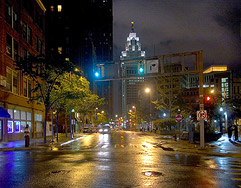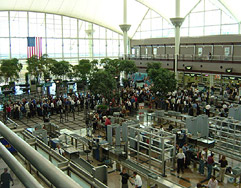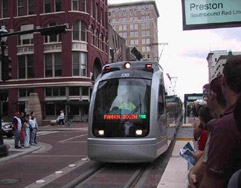Innovation NewsBriefs
Vol. 22, No. 2
“Spend first, answer questions later.” So concludes a critical editorial in the January 12 edition of the Washington Post, commenting on California’s proposed $43 billion High-Speed Rail program. The Post editorial, along with a January 11 article in the New York Times (both of which we reprint below), are emblematic of the increasingly skeptical press and public opinion concerning the fiscal and economic soundness of the Obama Administration’s high-speed rail initiative. “It’s unclear that the public benefits attributed to high-speed rail…would outweigh the inevitable operating subsidies,” observes the Washington Post, confirming the conclusions already reached by the states of Wisconsin, Ohio and Iowa.
Other states and their freight railroad partners seemingly are having similar second thoughts, judging from the parties’ lack of progress in reaching cooperative track-sharing agreements. Conspicuous among them is the state of Florida which has been promised a $2.4 billion federal grant to build an 84-mile “high-speed” line from Tampa to Orlando. That line, by all evidence, is too short to produce any meaningful time savings over car trips along a parallel interstate freeway. Moreover, as the New York Times article points out, the proposed line has scored among the lowest in terms of projected ridership in a study of the nation’s high-speed rail corridors recently published by America 2050, a national urban planning initiative (www.America2050.org). Its authors cited the low population and employment density of the cities at either end of the line (and a lack of internal transit distribution systems, we might add) as the reason for low ridership estimates and the line’s low score. The article notes that “the report represents another blow to the Florida high-speed rail network after a report from the Reason Foundation found the project could cost Florida taxpayers $3 billion.”
As the Washington Post editorial observed, “The president has a vision of a national high-speed rail network almost as grand as the interstate highway system. We have our doubts about the ultimate feasibility of this vision, in part because in much of the country passenger rail can’t compete with car travel by interstate highways.” The editorial could also have noted one other fundamental difference. Pres. Eisenhower’s ambitious plan for the interstate highway system was placed on a sound fiscal basis by being backed by a user fee (aka the gas tax). Mr. Obama’s high-speed rail vision, on the other hand is funded by a one-time $8 billion federal stimulus grant with no visible source of continued support. Indeed, the high-speed rail initiative faces little prospect of sustained congressional funding, it has yet to show evidence of attracting private capital, and it exposes the taxpayers to continued operating subsidies,as Amtrak experience suggests.
No wonder Pres. Obama’s vision is increasingly being questioned, even by the mainstream media.
…
The Washington Post, Wednesday, January 12, 2011
Hit The Brakes
ON PAPER, California appears a promising venue for high-speed passenger trains like the ones that streak across Japan and Western Europe. It’s got a string of urban centers from Sacramento to San Diego and lots of flat real estate in between. In 2008, its voters approved a $9.95 billion bond issue to pay about a quarter of the total projected $43 billion cost of a statewide high-speed system. Events since then, however, suggest that this grand plan is still a bit half-baked.
In November, the California High-Speed Rail Peer Review Group informed the legislature that the project suffers from an undefined business model and the “lack of a clear financial plan.” Most damning, the report noted that official estimates of how many people might actually want to ride the system are so unreliable that they “offer little basis for proceeding.” Ridership is a crucial variable, because the law authorizing high-speed rail bonds included a ban on state operating subsidies once the system is up and running.
The Peer Review Group’s report was only the latest in a series of skeptical blue-ribbon documents. But, undaunted, the California High-Speed Rail Authority announced last month that it would at last begin construction – on a stretch connecting not, say, Los Angeles and Anaheim but two obscure locations in the state’s rural Central Valley. The 120-mile segment would cost $5.5 billion. Critics quickly dubbed it a “train to nowhere” – a bit unfair, since some of the towns along the way have expensively redeveloped downtowns that may now suffer from the frequent noise and vibration of trains roaring through them.
This would be a matter of purely West Coast interest but for the fact that the U.S. government is paying more than half the cost of the new track, including $600 million newly diverted from Midwestern states that rejected the funds. Indeed, the Federal Rail Administration required that the money be spent in the Central Valley. It was the part of the state most likely to be ready to use it by a September 2011 deadline, because local property owners in more populated areas are stirring opposition, which drags out the environmental review process.
Given that California’s system has attracted zero private capital and has been unable to guarantee any source – governmental or private – for almost half the cost of completion, the obvious risk is that the federal taxpayer will be on the hook for billions of dollars worth of railroad track that may never serve its intended high-speed purpose. But the Obama administration sought the funds, as part of the 2009 stimulus package, and Congress approved them – and so they must be spent.
The president has a vision of a national high-speed rail network almost as grand as the interstate highway system. We have our doubts about the ultimate feasibility of this vision, in part because in much of the country passenger rail can’t compete with car travel by interstate highways. It’s unclear that the public benefits attributed to high-speed rail – reduced carbon emissions and less airport congestion – would outweigh the inevitable operating subsidies, as Amtrak’s experience suggests.
If federal high-speed rail investment makes sense at all, it’s probably in the densely populated Northeast Corridor, where demand for passenger trains is highest. At the very least, California should have to fill in its project’s economic and logistical blanks before any more money – from state taxpayers or the rest of us – is spent. Unfortunately, the rule right now seems to be spend
first, answer questions later.
…
The New York Times, January 11, 2011
Florida Has Federal Cash for High-Speed Rail but Lacks Ridership
By Jason Plautz
Although it has received nearly $2.4 billion in federal high-speed rail grants, Florida’s tri-city rail project may not be the best use for that money, a new report from an urban planning group has found.
The report from America 2050 evaluated U.S. regions to find the intercity corridors that would have the highest ridership and displace other forms of travel. Lines in the Northeast Corridor and a proposed route connecting California’s largest cities scored the best, while Florida’s tri-city route connecting Orlando, Miami and Tampa ranked much lower.
The three separate lines averaged just over 13 points on the study’s scale, compared to 20.15 points for a New York City-Washington, D.C., line and 18 for the Los Angeles-San Francisco route. The Tampa-Orlando line — thought to be the system closest to completion — also scored below lower-profile lines connecting Chicago to Minneapolis and Atlanta to Birmingham, Ala.
Still, Florida has gotten the second-highest amount in federal grants, trailing only California, and state planners say they could break ground as early as 2012. Rail advocates have looked to the state as their best shot of getting a system in place to act as a model for the rest of the country.
The report analyzed cities based on regional and city population density, employment centers, transit accessibility, air travel markets and demographics. Routes were analyzed as links between two cities rather than full regional networks.
Its authors cited Florida’s lack of a “megacity” like Boston or New York as a reason for the state’s low scores, noting that the tracks would be connecting comparatively low population centers without high employment density. However, the authors did not include tourism traffic in their report, which could have hurt the state’s evaluation. The flow of visitors to Orlando’s theme parks is expected to account for a good portion of the ridership on the lines.
Lines in the Northeast Corridor scored well, confirming the belief of many high-speed rail advocates that a Washington-New York-Boston network would be the most traveled and productive corridor. That corridor has received less than $200 million in federal grants, but Amtrak is exploring significant upgrades to existing services.
The report backs the Los Angeles-San Francisco line, which has gotten more than $3 billion in funding, and says a Los Angeles-Las Vegas line also would see strong ridership.
The report also shows potential for some lines that have not received as much attention, including a Washington, D.C.-Richmond, Va., line and another connecting larger cities in Texas. The latter project has gotten $6 million in federal grants for some early planning work.
The report’s authors say their approach would be the best way to evaluate and distribute federal funding for the high-speed rail program. Currently, the funds are given out through competitive grants that account for several factors on top of ridership, including environmental impact, right-of-way acquisitions and local support.
“America 2050 strongly believes that investments in [high-speed rail] will be essential to the long-term economic success and mobility of the nation and its megaregions,” said Robert Yaro, co-chairman of the group. “The report recommends, however, that the federal government adopt a data-driven, ridership-based approach to choosing rail corridors for federal investment in
the future in order to direct funding toward projects with the greatest market demand.”
The report represents another blow to the Florida high-speed rail network after a report last week from the conservative Reason Foundation found the project could cost taxpayers $3 billion. Gov. Rick Scott has not said whether he will continue the state’s project, saying he needs to see a feasibility study before he can make a decision.
…
C. Kenneth Orski is a public policy consultant and former principal of the Urban Mobility Corporation. He has worked professionally in the field of transportation for over 30 years, in both the public and private sector. He is editor and publisher of Innovation NewsBriefs, now in its 22nd year of publication.
Tags: C. Kenneth Orski, HSR, Innovation Newsbriefs, Jason Plautz, Ken Orski, New York Times, Washington Post






 RSS Feed
RSS Feed